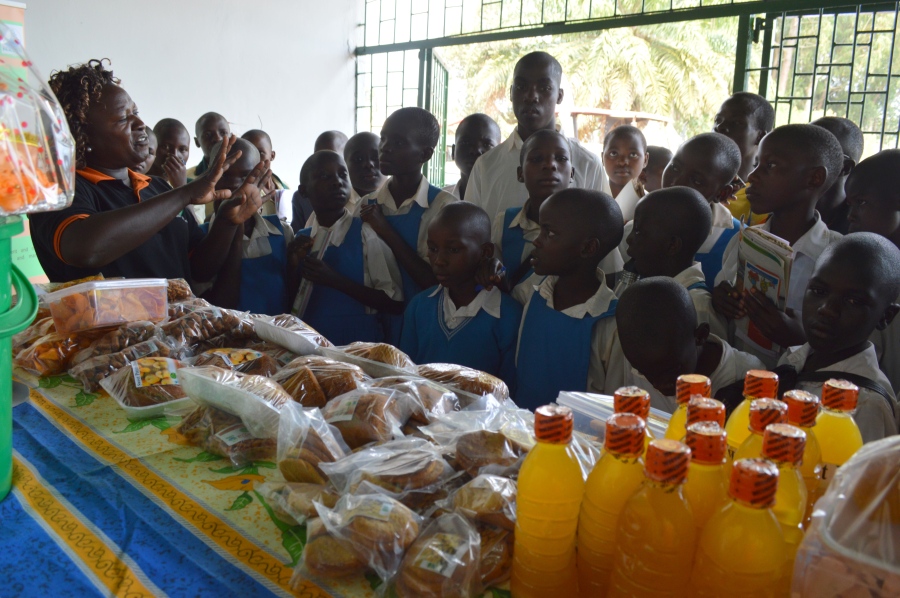Last month I was invited to the Source of the Nile agricultural trade show in Jinja, Uganda. The show brings together all aspects of agriculture: from crops to chickens, cows and tractors. The event attracts over 120,000 visitors each year and runs for seven days.
I was needed on a National Crops Resources Research Institute (NaCRRI) stand where Agnes Alajo (a PhD student and breeder) was selling improved sweet potato varieties, which are resistant to pests and diseases with higher levels of pro-vitamin A.
It is estimated that around 35% of children and 55% of child-bearing mothers in rural Uganda suffer from vitamin A deficiency, which is associated with preventable child blindness and mortality. The orange-fleshed NAROSPOT varieties developed by NaCRRI are enriched with pro-vitamin A and it’s hoped their adoption will help improve the deficiency problem.
The stand also had an impressive array of biscuits, cakes and even juice made from processing sweet potato. Agriculture is very important in Uganda; it accounts for around 24% of GDP and 43% of the working population are subsistence farmers (2013). Processing sweet potatoes to produce flour can be economically viable and provides farmers with an opportunity to add value to their crop, boost income and reduce poverty.
I had to hurriedly absorb information about sweet potato, as very soon hoards of excited school children arrived. The main challenge was that not everyone can speak English and my UK accent was quite difficult for them to understand. I had to speak clearly and slowly to get my message across. Often teachers had to repeat what I had said in their local language. There are over 40 local languages in Uganda, so even Ugandans can find it difficult to communicate!
Agnes explains the importance of pro-vitamin A rich sweet potatoes to school students
There was a lot of interest from young people who want to pursue agricultural careers and are attracted to opportunities for commercialization. Most people were very intrigued about the cakes, and couldn’t believe that they were made using sweet potato flour. Unfortunately, we couldn’t give out samples to taste until the end of the week, which caused a lot of pleading and disappointment!
I had a great time walking around. There was plenty of entertainment and I also got to see where the Nile flows from Lake Victoria!
More from this blog series:
I was needed on a National Crops Resources Research Institute (NaCRRI) stand where Agnes Alajo (a PhD student and breeder) was selling improved sweet potato varieties, which are resistant to pests and diseases with higher levels of pro-vitamin A.
It is estimated that around 35% of children and 55% of child-bearing mothers in rural Uganda suffer from vitamin A deficiency, which is associated with preventable child blindness and mortality. The orange-fleshed NAROSPOT varieties developed by NaCRRI are enriched with pro-vitamin A and it’s hoped their adoption will help improve the deficiency problem.
The stand also had an impressive array of biscuits, cakes and even juice made from processing sweet potato. Agriculture is very important in Uganda; it accounts for around 24% of GDP and 43% of the working population are subsistence farmers (2013). Processing sweet potatoes to produce flour can be economically viable and provides farmers with an opportunity to add value to their crop, boost income and reduce poverty.
 |
| The range of products made through processing sweet potato |
 |
| Agnes explains the importance of pro-vitamin A rich sweet potatoes to school students |
There was a lot of interest from young people who want to pursue agricultural careers and are attracted to opportunities for commercialization. Most people were very intrigued about the cakes, and couldn’t believe that they were made using sweet potato flour. Unfortunately, we couldn’t give out samples to taste until the end of the week, which caused a lot of pleading and disappointment!
 |
| Walking around the show I discovered giant cassava tubers, a “speaking head” and impressive looking cabbages. I later saw the source of the Nile itself! |
-----------------------------------
This blog has been written by University of Bristol Cabot Institute member Katie Tomlinson from the School of Biological Sciences. Katie's area of research is to generate and exploit an improved understanding of cassava brown streak disease (CBSD) to ensure sustainable cassava production in Africa. This blog has been reposted with kind permission from Katie's blog Cassava Virus.
 |
| Katie Tomlinson |
Blog 2: Week one: Settling in to Ugandan life
Blog 3: Learning the ropes
Blog 4: Clean cassava to solve brown streak problem?
Blog 5: Taking a trip to the cassava field!
Blog 6: Using GM to fight cassava brown streak disease
Blog 3: Learning the ropes
Blog 4: Clean cassava to solve brown streak problem?
Blog 5: Taking a trip to the cassava field!
Blog 6: Using GM to fight cassava brown streak disease

